Part 3: Building A Balanced Gaming PC
What does it mean to build a truly-balanced PC? How great would it be to piece together a machine bottlenecked by neither CPU or GPU? We set forth to measure the perfect balance in seven different games and four resolutions in this third of many parts.
Graphics Cards

If you have any hope of playing the latest games in their full glory (by which we mean max'ed out details) and at high native LCD resolutions, we can’t overstate how important it is to have a powerful graphics card in your system. For our purpose here, we chose cards from ATI and Nvidia, covering (at the time) a snapshot of the available gaming solutions priced roughly $100 and up.
Naturally, a series of this magnitude takes many months to plan for and test for, and we can’t possibly introduce new hardware without eliminating some of the previous-generation hardware. We bring in three ATI Radeon HD 5000-series DirectX 11 cards, while replacing the Radeon HD 4870 X2 (which is no longer available) and the Radeon HD 4850 (which is waning). The Radeon HD 4890 remains to represent ATI’s 4000-series, and all three Nvidia GeForce GTX 200-series cards return once again in this episode.
Asus EAH5970
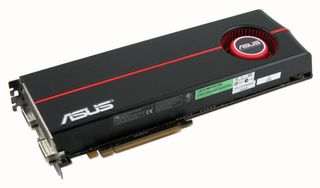
The dual-GPU AMD Radeon HD 5970 is currently the most powerful gaming card you can buy. Each GPU is clocked at 725 MHz and features 1,600 shader processors, 80 texture units, 32 ROPS, 1GB of GDDR5 clocked at 1,000 MHz, and a dedicated 256-bit memory interface.
This beastly flagship is slightly over a foot long, and will set you back around $700. What you're getting in return, however, is essentially two Cypress XT GPUs with clock speeds lowered to match the Radeon HD 5850, all packed onto a single PCB.
Asus EAH5870
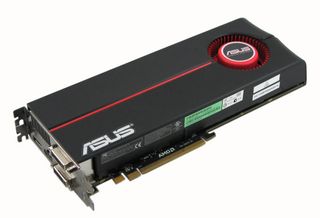
AMD's fasted single-GPU card is the Radeon HD 5870, which adds current-generation features, while matching the performance of the former dual-GPU Radeon HD 4870 X2. The card measures 11 inches long and has the same basic specs as each GPU on the Radeon HD 5970, but with an 850 MHz core and a 1,200 MHz GDDR5 memory clock.
Stay on the Cutting Edge
Join the experts who read Tom's Hardware for the inside track on enthusiast PC tech news — and have for over 25 years. We'll send breaking news and in-depth reviews of CPUs, GPUs, AI, maker hardware and more straight to your inbox.
Asus EAH5750 Formula

The affordable Radeon HD 5750 has 720 shader processors, 36 texture units, 16 ROPS, and a 128-bit memory interface. Asus outfits this card with a unique non-reference “Formula fansink” design and a slightly different array of display outputs. But the GPU is clocked at 700 MHz, complemented by 1GB of GDDR5 running at 1,150 MHz, just like a reference card.
BFG GeForce GTX 295
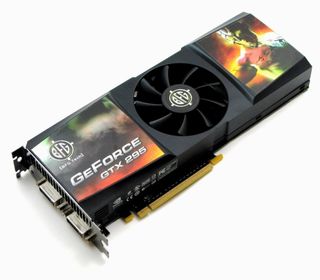
Representing the flagship of Nvidia’s GTX 200-series is the BFG GeForce GTX 295. Unlike the original GTX 295s, built on two PCB's, this newer revision features two GT200b GPUs on a single PCB.
Sporting a total of 1,792MB GDDR3 (896MB per GPU), two 448-bit memory interfaces, a 576 MHz core clock rate, a 1,242 MHz shader clock, and a 999 MHz memory clock, each GPU has the general specifications of Nvidia's GeForce GTX 260. However, the GPUs themselves boast a full 240 stream processing cores, like the GeForce GTX 285, GeForce GTX 280, and GeForce GTX 275.
BFG GeForce GTX 285 OCFU
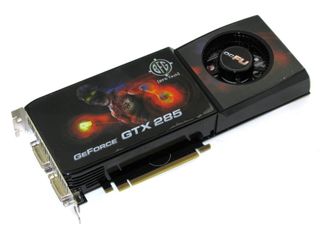
This BFG GeForce GTX 285 OCFU represented the most powerful single-GPU card available back during our first round of testing. Its features include 240 shader processors, a 712 MHz core clock rate, a 1,620 MHz shader clock rate, 1GB of GDDR3 memory running at 1,332 MHz (2,664 MHz effective), and a 512-bit memory interface. These are extremely high (albeit overclocked) clock rates right out of the box, backed by BFG’s lifetime warranty.
For Part 1 and Part 2 testing, we down-clocked this board to reference GeForce GTX 285 speeds of 648 MHz (core), 1,476 MHz (shader), and 1,242 MHz (memory). In Parts 3 and 4, we utilize BFG’s factory overclock speeds listed above.
BFG GeForce GTX 260 OCX Max Core 55
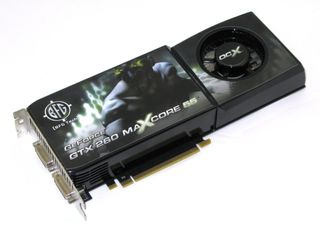
The BFG GeForce GTX 260 OCX Max Core 55 combines 216 shader processors, 896MB of GDDR3 memory, BFG’s highest factory overclock on a GeForce GTX 260 of 655 MHz core, 1,404 shader, and 1,125 MHz on the memory clock (2,250 MHz effective). Of course, it's also covered by BFG’s lifetime warranty.
We again down-clocked this board to reference speeds of 576 MHz core, 1,242 MHz shader, and 999 MHz memory frequencies for initial testing in Part 1 and 2, but run BFG’s OCX Max Core 55 speeds during this round of testing.
ATI Radeon HD 4890
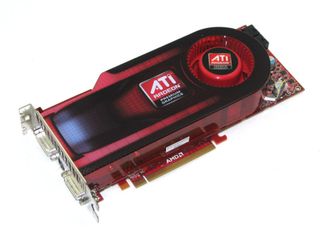
Representing AMD’s top single-GPU card from the 4000-series generation, the Radeon HD 4890 has the same vital GPU specifications as the Radeon HD 4870, like 1GB of GDDR5 memory, 800 shader processors, 40 texture units, 16 ROPs, and a 256-bit memory bus. However, the RV790 graphics processor made it possible for AMD to serve up higher clock rates (up to 850 MHz on the core and 975 MHz memory).
Graphics cards appearing in Parts 1 & 2:
ATI Radeon HD 4870 X2

The flagship of AMD’s Radeon HD 4800-series is the Radeon HD 4870 X2, a card consisting of two Radeon HD 4870 GPUs. Each processor has its own dedicated 1GB GDDR5 (2GB total) frame buffer. The individual GPU specs are identical to a single-chip Radeon HD 4870, including 800 stream processors, 40 texture units, 16 ROPs (Raster Operation Units), a 256-bit memory bus, 750 MHz GPU, and 900 MHz memory frequency.
HIS Radeon HD 4850 512MB

The HIS Radeon HD 4850 has the same 800 ALUs, 40 texture units, and 16 ROPs as its bigger brothers, but it also has a lower GPU clock of 625MHz and 512MB of GDDR3 running at 993 MHz (1,986 MHz effective).
As a reminder: The majority of the testing for this piece was complete prior to Nvidia’s GeForce GTX 480 and GTX 470 launch. To see how these new cards stack up to the ones used today, be sure to check out our launch review here.
Special thanks to Asus, AMD, and Nvidia for arranging the graphics hardware needed to make this entire series possible.
-
liquidsnake718 I love how on the first page picture of all the games on this article show the games that truly take a toll on GPU's and CPU's. You are however missing Metro 2033 and Dirt 2 in DX11 which obliterates some GPUs in DX11!Reply -
IzzyCraft A metro 2033 graph wouldn't be interesting it would start at 0 and end at 5 for most set ups :DReply -
The choice of Corsair Dominator for the RAM is surprising, given that there are equally fast and stable choices at a much lower price point. OCZ, G Skill, Crucial, etc. I still love their power supplies though.Reply
-
duk3 ColMirageGlad to see the last part of the series. Very useful!Reply
They mentioned a part 4 in the article, with overclocking AMD processors. -
kaintfm The choice of Corsair Dominator for the RAM is surprising, given that there are equally fast and stable choices at a much lower price point. OCZ, G Skill, Crucial, etc. I still love their power supplies though.Reply -
agnickolov And where is the Core i3 530? This is the real gaming gem of a CPU, but I hardly see it in any reviews @ Tom's...Reply -
manitoublack Bought 2 GTX295's on release and run them on my i7-920, in SLi at 640MHz. Still over a year on and there still almost top dog.Reply
Great review Toms, and makes it easier to sleep at night knowing that 14months on little can touch what I've got regardless of the $1600AUD buyin. -
FUtomNOreg Very enlightening though, given my current rig's specs, thoroughly depressing. Curse you for breaking my delusion that my PC was adequate! I feel an overwhelming urge to upgrade coming on.....Reply
Most Popular

